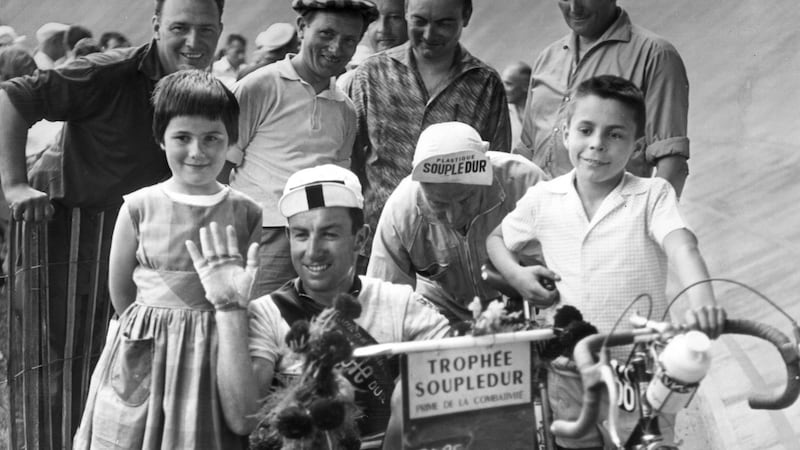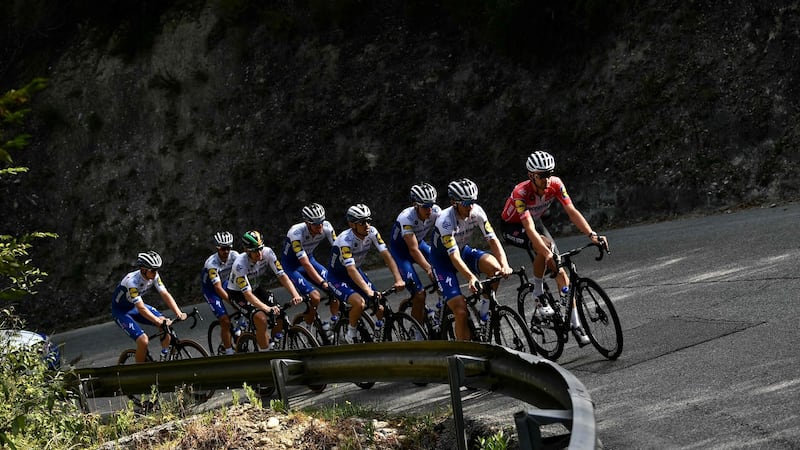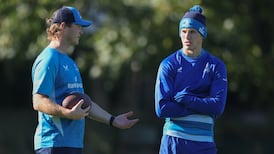The question of which Irish rider has worn the most yellow jerseys in the Tour de France typically throws most people: few guess Shay Elliott and Stephen Roche.
The story goes that in 1919, in what was already the 13th edition of the Tour, Henri Desgrange, editor-in-chief of race sponsor and organiser L'Auto newspaper, decided the overall leader should wear a yellow jersey to distinguish him from the rest of the peloton.
It was to be and still remains an elite and exclusive club, only 286 different riders, from 23 countries, in all getting to wear the maillot jaune in the 100 years since – not including those later stripped of it for doping.
Along with Elliott and Roche, who each wore yellow three times, Seán Kelly is the only other Irish rider in that club, and that was for one day only.
In 1959 Elliott also became the first Irish rider to start the Tour, and four years after that, on June 25th, 1963, he won stage 3 from Jambes, in Belgium, to Roubaix, his 33-second victory margin enough to give him his first yellow jersey. Elliott wore the leader's jersey for the next three days, before losing it in the time-trial on stage 6.

In 1983 Kelly then bridged the 20-year gap between Elliott's yellow, earning enough bonus points on stage 9 of the 1983 Tour, which took the riders from Bordeaux to Pau, to take an overall one-second lead. He wore the jersey for one day – and despite all the success that followed never won it back again either.
Four years after that Roche rode himself into the yellow jersey on stage 19 of the 1987 Tour, into Villard-de-Lans, only to lose it the following day to Pedro Delgado of Spain, on the final climb to Alpe d'Huez. Roche then tracked Delgado until the penultimate time-trial in Dijon on stage 24, where he won back the yellow jersey and wore it again the next day into the finish at Paris. Like Elliott and Kelly he never won it back in a different Tour either.
With his son Nicolas Roche, his nephew Dan Martin, and Sam Bennett the three Irish riders in this year's race, there is now the question can that gap be bridged again. With an unconventionally mountainous route, visiting all five of France's mountain ranges, including 29 categorised climbs and five summit finishes, the 2020 Tour is being billed as the most unpredictable in years, particularly given all the unknowns around Covid-19 (if two members of any team test positive that team must abandon, etc).
But that chance begins with Saturday’s opening stage, the 156km around Nice, which offers the prospect of an Irish stage win, and with that a fourth Irish rider to wear yellow.

Stage 1, August 29th: Nice-Nice 156km
Three scenic loops around the city, two short and one long, does include the leg-testing climb of the Côte de Rimiez, but with a finish on the fast Promenade des Anglais, 38km after the last bit of uphill, this should be sprinter-made, and not too unlike the testing finish of stage 4 at Vuelta a Burgos earlier this month where Sam Bennett demolished his opposition.
Stage 3, August 31st: Nice-Sisteron, 198km
Following the magnificently scenic Route Napoléon, rolling up over 3km in vertical climbing, this turn should develop into a sprinter’s paradise down the last 50km from the beautiful Digne les Bains, where Bennett’s hunger for another stage win may or may not be even more.
Stage 6, September 3rd: Le Teil-Mont Aigoual, 191km
Entering the Massif Central, this is mostly unfamiliar Tour de France country, the first and last time a stage ascended Mont Aigoual being 1987, when Roche was en route to winning the Tour, before completing the Triple Crown. With a 12km ascent to the Col de la Lusette before the main 8km drag to the finish, this demands strength and will, perfect for Dan Martin, and perhaps even to inspire Nicolas Roche, given the links with his father here.
Stage 9, September 6th: Pau-Laruns, 154km
Coming after the first rest day, opportunity may knock for many, and Martin will again fancy his chances, given he knows this gateway to the Pyrenees well, living in nearby Andorra. Though starting and not finishing in Pau, it was also in these parts that Irish rider Martin Earley won his Tour stage in 1989, first on stage 9 from Labastide-d'Armagnac into Pau, as was Kelly back in 1983. Roche may also fancy this stage given it has breakaway potential.
Stage 11, September 9th: Chatelaillon Plage-Poitiers, 167km
The last of the truly straightforward stages before the Champs Élysées, heading towards Poitiers on mostly sheltered roads via Saint Maixent l’Ecole and unfolding on a beautiful main road, it may also be Bennett’s last chance to land that stage win before Paris, if he hasn’t already, and assuming he will get that far.
Stage 21, September 20th: Mantes-la-Jolie-Paris Champs Élysées, 122km
Already shaping up as one of the most unpredictable Tour finishes in cycling history, simply because it faces the myriad of additional challenges around Covid-19, whichever riders do make it to Paris will be excited by the prospect of this stage. The maillot jaune will have been decided the previous day on the 36km time-trial, the only one of the three weeks, to La Planche des Belles Filles, which means if Bennett is still in the race, he will be unquestionably one to watch.
The Irish Tour de France in numbers
Number of Irish finishers – 10: Shay Elliott, Seán Kelly, Stephen Roche, Martin Earley, Paul Kimmage, Laurence Roche, Mark Scanlon, Nicolas Roche, Dan Martin, Sam Bennett.
Number of Irish stage winners – 5: Shay Elliott, Seán Kelly, Stephen Roche, Martin Earley, Dan Martin.
Number of Irish yellow jersey wearers – 3: Shay Elliott, Sean Kelly, Stephen Roche.
Number of Irish yellow jersey winners – 1: Stephen Roche.
Number of Irish green jersey – 1: Seán Kelly














